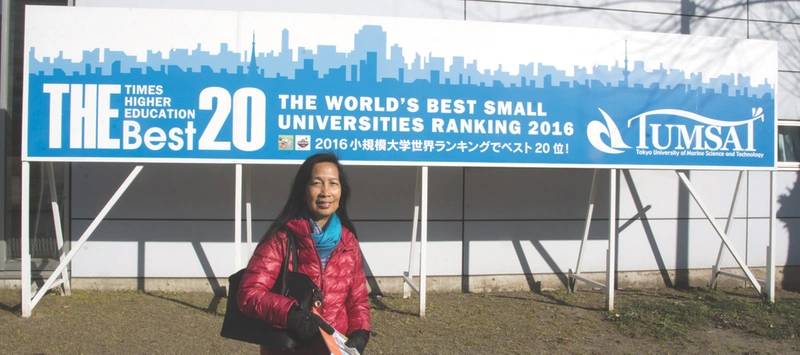TUMSAT: More than a Rowing School
Philippine-born Ananya Surangpimol won a prestigious scholarship to Japan in 1971 and, after a year of intensive Japanese, entered Tokyo University of Fisheries, one of the first Asian women to do so in a former all-male imperial university. There she completed a master’s degree in food science but one of her favorite memories of her attendance at this former naval academy was being required to swim a kilometer in the open sea and row a big 12-oar cutter in her freshman year.
In 2003, Tokyo University of Fisheries merged with the Tokyo University of Mercantile Marine to form the Tokyo University of Marine Science and Technology (TUMSAT), bringing their histories and reputations from way back in 1888 and 1875, respectively. Attendance by women has increased to about 40 percentfrom the 1970s when it started at 2 percent.
Recently, Surangpimol, now a Thai citizen, returned to her old Shinagawa campus, located a short distance up the Keihin Canal from Tokyo Bay, for the first time in 40 years. She was delighted to see a 12-oar cutter being rowed up the river by students, male as well as female.
On the shore, the same boat basin that she remembered from her student days contained a 19-meter research and training boat. It is the smallest of four vessels that the university operates. The 1,886-ton flag ship, Umitaka-maru, was away at the time. It travels to all oceans of the world and regularly visits the Antarctic. In addition to research responsibilities, the vessel is used to teach advanced courses of fisheries and ocean navigation. In February of this year, the 17-year-old, 93 by 15-m training ship was in the South Pacific. Also operated by TUMSAT are the 64.5-meter Shinyo-maru, the 35.5-meter Seiyo-maru and the 19-meter Hiyodori.
Near the boat basin, a large boathouse contained several big rowing boats. Two of the largest, 14 meters with 14 oars and sail, were in the boathouse while the third 14-meter boat was the one that students were rowing up the river. These are lovely slim vessels with the clinker style planking replicated in fiberglass. Next to them are three nine-meter carvel-style fiberglass boats. These boats have no sail but are manned by 12 oarsmen. A number of smaller vessels are to be found amidst a profusion of nautical fenders, oars, supplies and even racing trophies.
Busy with cleaning and tidying, while their crewmates were out rowing, a young couple, Yamada Masafumi and Tsukada Kaoru took time to explain the current role of rowing at the university. Yamada, who is a rowing-team member, explained that they have competitions with other marine universities in Japan. The two-kilometer races turn at the halfway mark and then return over the same one-kilometer course. The boats are crewed with one man per oar as well as a captain on the rudder and a chanter to call the stroke with a pace set by the captain. Tsukada, who does coordination work for the team, said that there were occasional one-kilometer races for women with smaller six-oar and six-meter boats but that these are not common.
Tsukada is in her first year at the School of Marine Resources & Environment while Yamada is in his third year in the School of Marine Technology. This will qualify him for a berth on the Umitaka-maru for a total of four months next year and then seven months the year after. The trips will take him down the coast of Australia and into Antarctic waters. After graduation, Yamada is looking forward to a career as a deck officer on deep-sea vessels. Tsukada, on the other hand, has not decided whether to get involved with environmental issues on land or on water. She is inclined, she says, to address human activity on land that impact marine resources as the ocean is too vast to reach.
A short distance from the boathouse is the school’s original training ship, the Unyo-maru, the most visible feature of the Shinagawa campus from the Haneda Airport monorail. A barque-type sailing ship built in 1909, it was brought ashore in 1962 and set up on static display. For the first 20 years of her life, she contributed to whaling training, fishery investigation, student training, as well as development of fishery skills and tools. Later in life she pioneered the onboard processing of crabs. Today, the Unyo-maru and the university’s training vessels, stand as symbols of the commitment of the Tokyo University of Marine Science and Technology to excellence in nautical training, ocean and fisheries research. At the entrance to the 3,000-student university, a sign proudly declares it to be one of the twenty best of the world’s small universities.
(As published in the April 2017 edition of Maritime Reporter & Engineering News)


